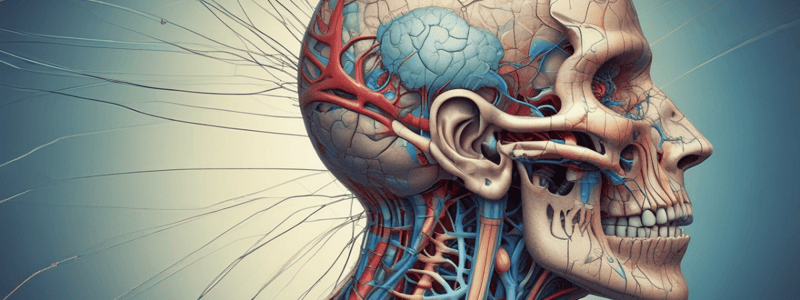Podcast
Questions and Answers
What is the main function of the olfactory nerve?
What is the main function of the olfactory nerve?
- To innervate the four extrinsic eye muscles
- To control the movement of the eye
- To detect smells (correct)
- To transmit visual information
What is the primary function of the optic nerve?
What is the primary function of the optic nerve?
- To transmit information from the nasal passage to the brain
- To transmit visual information from the retina to the brain (correct)
- To control the movement of the eye
- To innervate the levator palpebrae superioris
What is a common symptom of oculomotor nerve disorders?
What is a common symptom of oculomotor nerve disorders?
- Loss of the sense of smell
- Double vision (correct)
- Numbness in the neck
- Tingling sensation in the face
What type of nerve is the trigeminal nerve?
What type of nerve is the trigeminal nerve?
Which nerve innervates the levator palpebrae superioris?
Which nerve innervates the levator palpebrae superioris?
What is the location of the primary visual cortex, where the brain processes visual information?
What is the location of the primary visual cortex, where the brain processes visual information?
Which cranial nerve is responsible for transmitting smell information from specialized olfactory neurons to the brain?
Which cranial nerve is responsible for transmitting smell information from specialized olfactory neurons to the brain?
Where does the optic nerve carry visual information from the retina in the eye?
Where does the optic nerve carry visual information from the retina in the eye?
Which cranial nerve is involved in controlling eye movements?
Which cranial nerve is involved in controlling eye movements?
Which structure does the trigeminal nerve innervate?
Which structure does the trigeminal nerve innervate?
What is the general pattern of cranial nerve naming?
What is the general pattern of cranial nerve naming?
Study Notes
Cranial Nerves: Understanding Their Function and Structure
The cranial nerves are a group of twelve nerves that originate in the brain and provide motor and sensory functions to the head and neck. Each cranial nerve has unique anatomical characteristics and functions, and doctors can identify neurological or psychiatric disorders by testing cranial nerve functions.
Olfactory Nerve Function
The olfactory nerve, also known as cranial nerve I, is responsible for detecting smells. It transmits information from olfactory receptors in the nasal passage to the brain. Damage to the olfactory nerve can result in anosmia, a condition characterized by a loss of the sense of smell.
Optic Nerve Anatomy
The optic nerve, or cranial nerve II, transmits visual information from the retina to the brain. It consists of a ganglion cell layer, optic nerve fiber layer, and the inner limiting membrane, which separates the retina from the vitreous humor. The optic nerve fibers project to the primary visual cortex in the occipital lobe, where the brain processes visual information.
Oculomotor Nerve Disorders
The oculomotor nerve, or cranial nerve III, controls the movement of the eye. It innervates the four extrinsic eye muscles and the levator palpebrae superioris. Oculomotor nerve disorders can cause eye movement issues, such as strabismus or double vision.
Trigeminal Nerve Pathway
The trigeminal nerve, or cranial nerve V, is a mixed nerve that carries both sensory and motor fibers. It innervates the face, including the scalp, forehead, nose, and other facial structures. Pathological conditions and lesions can affect the trigeminal nerve, leading to pain or other symptoms.
Cerebral Nerve Innervation
Cranial nerve innervation to the cerebrum includes the olfactory nerve (CN I) and optic nerve (CN II). The olfactory nerve transmits smell information from specialized olfactory neurons to the brain, while the optic nerve carries visual information from the retina to the primary visual cortex in the occipital lobe.
Cranial nerves are named according to their function and location in the brain, with Roman numerals from I to XII. The olfactory nerve is the cranial nerve responsible for smell, while the optic nerve enables vision. Other cranial nerves are involved in controlling eye movements (oculomotor, trochlear, abducens), facial and sensory functions (trigeminal), and communication and autonomic regulation (glossopharyngeal, vagus, spinal accessory, and hypoglossal).
Studying That Suits You
Use AI to generate personalized quizzes and flashcards to suit your learning preferences.
Description
This quiz covers the anatomy and functions of the 12 cranial nerves, including their role in sensory and motor functions, and common disorders associated with them. Test your knowledge of cranial nerve structure, function, and related disorders.




